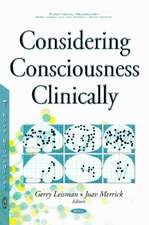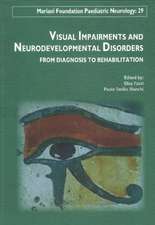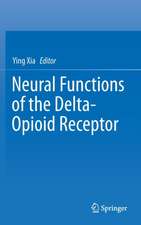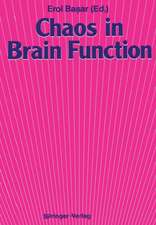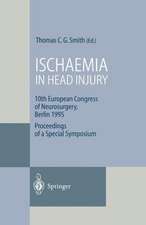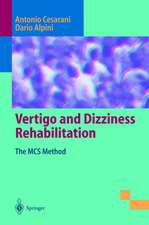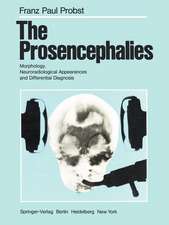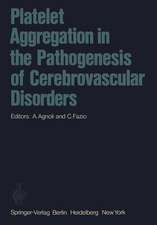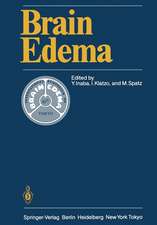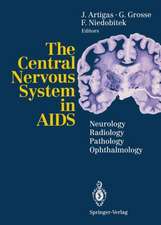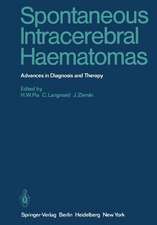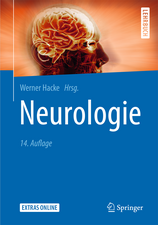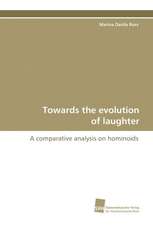Vertigo Rehabilitation Protocols
Autor Dario Carlo Alpini, Antonio Cesarani, Guido Brugnonien Limba Engleză Paperback – 6 iun 2014
Preț: 939.05 lei
Preț vechi: 988.47 lei
-5% Nou
Puncte Express: 1409
Preț estimativ în valută:
179.69€ • 192.15$ • 149.82£
179.69€ • 192.15$ • 149.82£
Carte tipărită la comandă
Livrare economică 17 aprilie-01 mai
Preluare comenzi: 021 569.72.76
Specificații
ISBN-13: 9783319054810
ISBN-10: 3319054813
Pagini: 244
Ilustrații: XII, 244 p. 141 illus., 25 illus. in color.
Dimensiuni: 155 x 235 x 12 mm
Greutate: 4.39 kg
Ediția:2014
Editura: Springer International Publishing
Colecția Springer
Locul publicării:Cham, Switzerland
ISBN-10: 3319054813
Pagini: 244
Ilustrații: XII, 244 p. 141 illus., 25 illus. in color.
Dimensiuni: 155 x 235 x 12 mm
Greutate: 4.39 kg
Ediția:2014
Editura: Springer International Publishing
Colecția Springer
Locul publicării:Cham, Switzerland
Public țintă
Professional/practitionerCuprins
From Bipedalism to the Vestibulo-Vertebral Unit.- Functional Organization of Human Balance Control as Basis for Rehabilitation Planning.- The MCS Model.- The Treatment Diagnosis.- Vestibular Rehab – from Cawthorne-Cooksey to Vertigo School.- Training Vestibular Rehab Protocols.- Sudden Unilateral Vestibular Loss Uncompensated Unilateral Vestibular Hypofunction.- Vestibular Ataxia.- Benign Paroxysmal Positional Vertigo.- Cervicogenic Vertigo and Dizziness.- Ménière Disease.- Dizziness and Unsteadiness in the Elderly.- Whiplash Associated Balance Disorders.- Phobic Postural Vertigo.- Autonomic Vertigo.- The Quantification of Rehab Outcome.
Textul de pe ultima copertă
This book describes in detail rehabilitation protocols specific for those disorders that most frequently induce vertigo and dizziness. In particular, it highlights exercise protocols that will enable the best result to be obtained within the shortest time and with the most enduring therapeutic effect. Drawing on their personal experience, the authors describe physical exercises that will prove effective in delivering vestibular rehabilitation all over the world, regardless of the rehabilitation tools available. The protocol standardization and the reduction in instrumental rehabilitation mean that even though some individual tailoring is required, it will be possible to plan cost-effective rehabilitation within both the institutional and the private practice setting.
The presented protocols cover vertigo in a wide range of conditions, including acute and chronic vestibular loss, vestibular ataxia, benign positional paroxysmal vertigo, Ménière’s disease, dizziness in the elderly, whiplash-associated balance disorders, phobic postural vertigo, and autonomic vertigo. Helpful information is provided on clinical approach to vertigo and dizziness and on vestibular rehabilitation from Cawthorne-Cooksey onward. The quantification of rehabilitation outcome and the role of life-style counseling are also discussed. By documenting effective functional and therapeutic approaches and presenting guidelines for each balance disorder, Vertigo Rehabilitation Protocols will be an invaluable resource for neurologists, ENT physicians, orthopedists, and rehabilitation specialists.
The presented protocols cover vertigo in a wide range of conditions, including acute and chronic vestibular loss, vestibular ataxia, benign positional paroxysmal vertigo, Ménière’s disease, dizziness in the elderly, whiplash-associated balance disorders, phobic postural vertigo, and autonomic vertigo. Helpful information is provided on clinical approach to vertigo and dizziness and on vestibular rehabilitation from Cawthorne-Cooksey onward. The quantification of rehabilitation outcome and the role of life-style counseling are also discussed. By documenting effective functional and therapeutic approaches and presenting guidelines for each balance disorder, Vertigo Rehabilitation Protocols will be an invaluable resource for neurologists, ENT physicians, orthopedists, and rehabilitation specialists.
Caracteristici
Provides an up-to-date and comprehensive overview of the functional model of balance control Includes innovative chapters on vestibular rehabilitation in phobic postural vertigo, autonomic vertigo and whiplash-associated balance disorders Highlights the role of lifestyle counseling in the treatment of vertigo and dizziness and the maintenance of positive results of vestibular rehabilitation




